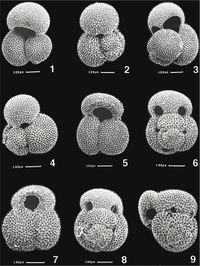Globigerinoides ruber
Globigerinoides ruber is a symbiont-bearing planktonic foraminifer commonly found in the surface water of the tropics and subtropics and often used in paleoceanographic studies as a sea surface temperature proxy. Globigerinoides ruber has been shown to tolerate hyposaline conditions and has been recovered from waters having salinities of 30.5 to 31 psu [1]. G. ruber exhibits two varieties, a pink and a white form. The pink variety occurs usually in the warmer waters of the Atlantic Ocean, whereas the white variety thrives at lower temperatures [2]. The pink variety disappeared from the Indian and Pacific Oceans during the Pleistocene [3].

Two morphotypes of G. ruber have been identified [4]: G. ruber sensu stricto (s.s.) and G. ruber sensu lato (s.l.) (Figure 1). These two morphotypes exhibit different taxonomic criteria, shell stable isotopic composition of oxygen and carbon, and habitat depth [4].
G. ruber s.s. refers to specimens with spherical chambers sitting symmetrically over previous sutures, with a wide, high-arched aperture bordered by a rim. On the other hand, G. ruber s.l. refers to specimens with more compressed chambers sitting asymmetrically over the previous sutures, with a small round or medium arched opening bordered by a rim and two small- to medium size, round supplementary suture apertures situated opposite to sutures of previous chambers [4].
The differences in stable oxygen and carbon isotope values are representative of different calcification depths for the two morphotypes, with G. ruber s.s. calcifying in the upper 30m of the water column, and G. ruber s.l. living at depths of 30-50m [4] [5]. These estimated calcification depths contrast with a sediment trap study from south Java [6], which show that the  values of the two morphotypes are virtually identical and consistent with an habitat depth between 0-30m.
values of the two morphotypes are virtually identical and consistent with an habitat depth between 0-30m.
References
- ↑ Bé, A. W. H., & Tolderund, D. S. (1971). Distribution and ecology of living planktonic foraminifera in surface waters of the Atlantic and Indian Oceans. In B. M. Funnell & W. R. Riedel (Eds.), The Micropaleoontology of Oceans (pp. 105-149). Cambridge, U.K.: Cambridge University Press.
- ↑ Hemleben, C., Spindler, M., & Anderson, O. R. (1989). Modern Planktonic Foraminifera. Berlin: Springer-Verlag.
- ↑ Thompson, P. R., Bè, A. W. H., Duplessy, J. C., & Shackleton, N. J. (1979). Disappearance of pink-pigmented Globigerinoides ruber at 120,000 yr BP in the Indian and Pacific Ocean. Nature, 280, 554-558.
- ↑ 4.0 4.1 4.2 4.3 4.4 Wang, L. (2000). Isotopic signal in two morphoypes of Globigerinoides ruber (white) from the South China Sea: implications for monsoon climate change during the last glacial cycle. . Palaeogeography, palaeoclimatology, palaeoecology, 161, 381-394.
- ↑ Kawahata, H. (2005). Stable isotopic composition of two morphotypes of Globigerinoides ruber (white) in the subtropical gyre in the North Pacific. Paleontological Research, 9(1), 27-35.
- ↑ Mohtadi, M., Steinke, S., Groeneveld, J., Fink, H. G., Rixen, T., Hebbeln, D., . . . Herunadi, B. (2009). Low-latitude control on seasonal and interannual changes in planktonic foraminiferal flux and shell geochemistry off south Java: A sediment trap study. Paleoceanography, 24, PA1201. doi:doi:10.1029/2008PA001636